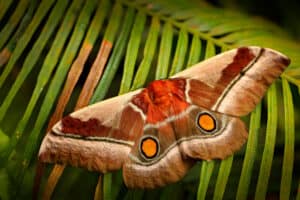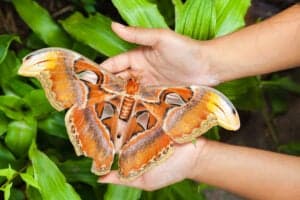The Atticus Atlas is a giant moth with a wingspan of up to 9.4 inches and a wing surface area of about 25 inches! Its wingspan is only surpassed by the white witch moth and the Attacus caesar moth, and its wing surface area is only surpassed by the Hercules moth. This makes it one of the largest lepidopterans in the world!
Tropical and subtropical rainforests are the primary habitats of these fascinating bugs. They’re mostly found in Asia, particularly Southeast Asia, which includes countries like Indonesia, Malaysia, Vietnam, Thailand, and Myanmar (Burma). They can also be found in nations in Asia such as Bangladesh, India, and Sri Lanka.
Atlas Moth Appearance

An Atlas moth has a wingspan of up to 9.4 inches!
©Cocos.Bounty/Shutterstock.com
What really makes these moths unique is their snake-like wings. To protect themselves from predators, Atlas moths have cobra-like designs on their upper wings, making them known as “snakeheads,” or as “snake’s heads.” From Greek mythology, the Atlas moth gets its name from the gigantic god Atlas, who had to carry the sky on his shoulders. The moth’s Cantonese name translates as “snake’s head moth,” due to the snake-like markings on its wings.
Visual Mimicry
The upper edge of each Atlas moth wing resembles the head of a cobra. This is called “visual mimicry.” A harmless organism (the mimic) replicates a model with a warning system (the model). Other organisms mistake it for the model and leave it alone. In biodiverse regions like rainforests, mimicry evolves over time. With enough species and time, random mutations can evolve into valuable features that are naturally selected.
Atlas moth visual mimicry is well documented. Birds and lizards, for example, are the Atlas moth’s primary predators and are mostly visual hunters. They tend to avoid the Atlas moth because of its snake-like appearance. This shows natural selection may have fine-tuned the pattern on its wings.
“Snake Head” Wing Patterns
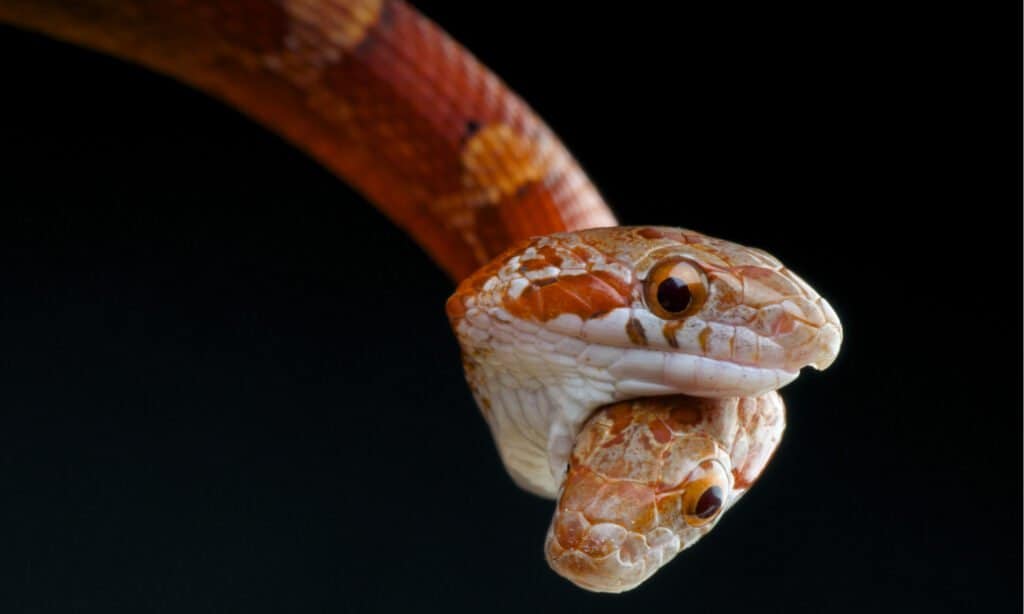
Atlas moths have wings that include elaborate decorations suggesting eyes or two snakeheads.
©reptiles4all/Shutterstock.com
To survive in a world where birds eat bugs, a little deception is vital! The Atlas moth’s wings include elaborate decorations suggesting eyes or two snakeheads, making it unappetizing to predators like birds and lizards. But it’s not just the markings on its wings that mimic snakes. As its wings move, they imitate the fluid movement of snake necks! Finally, its size can deter predators and make the illusion of a snake even more believable.
The Atlas moth’s wings also have translucent patches that can function as “eyespots” in addition to the markings. These artificial eyes could both scare predators and distract them from more susceptible moth parts. For example, wing injury is not as severe as damage to the moth’s head or body if a stubborn predator attacks the eyespots.
Other Mimicry Examples In The Animal Kingdom
The Atlas moth is not the only animal species known to use mimicry to survive. This occurs frequently in nature. Most animals have either adapted to look like a more dangerous version of their species or employ camouflage to blend into their current environment. The main distinction is that mimicry involves mimicking another organism or part of an organism, while camouflage includes copying an environment. Below are some additional examples of mimicry in nature.
Other Butterflies
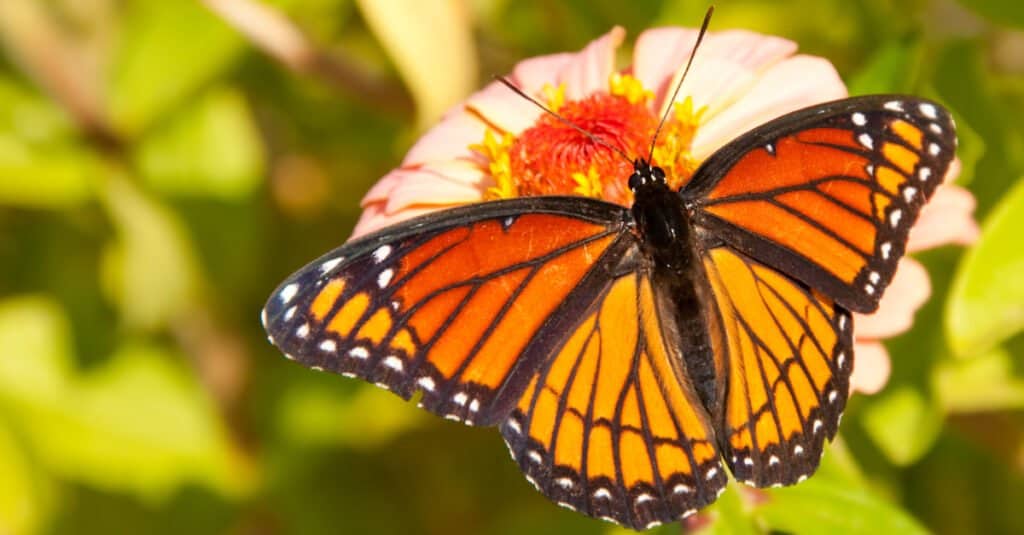
Harmless viceroy butterflies use Batesian mimicry to defend themselves against predators.
©Sari ONeal/Shutterstock.com
Viceroy butterflies are tasty to predators and have evolved wings that resemble monarch butterflies, thus minimizing predation. Adult spicebush swallowtail butterflies, who happen to be tasty to birds, mimic the distasteful pipevine swallowtail butterfly so birds avoid them. Tiger leafwing butterflies have evolved to resemble Ismenius tiger butterflies since birds loathe the Ismenius tiger butterfly.
Plants and Insects
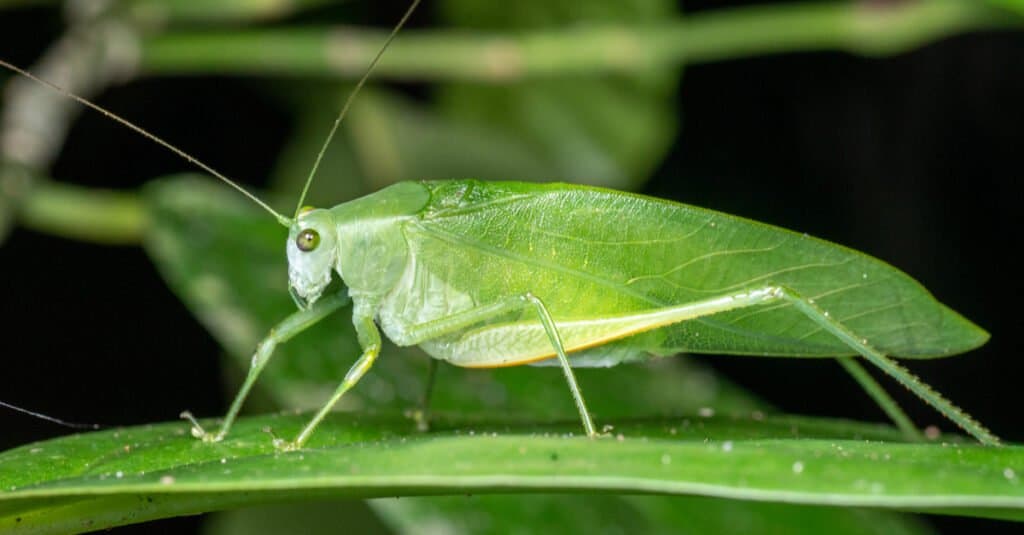
Katydids may be excessively loud, but their leaf-like camouflage is an effective layer of defense.
©Peter Yeeles/Shutterstock.com
Plants have mimicry attributes as well. A chameleon vine, for example, changes its leaf color and shape to match the plant it is climbing. The chameleon vine’s edible leaves appear to be the host plant’s undesirable leaves.
Animals and insects often blend into the plants they climb on too. Grasshoppers and katydids are just two examples. The shades of green that jacket the larger anglewing katydid keep it well disguised among grasses and lush foliage. Grasshoppers are likewise similarly disguised. Camouflage such as this is a form of visual mimicry that has been adapted to blend in with its surroundings.
Snakes

The gopher snake mimics the rattlesnake by swinging its tail like a rattle to scare off predators.
©rawaccess/Shutterstock.com
The milk snake is a harmless kingsnake species. It has similar color patterns to coral snakes. Venomous coral snakes, however, can injure humans and animals. In this scenario, the model is the coral snake, while the mimic is the milk snake. Like coral snakes, milk snakes feature black, red, and yellow bands, but the yellow bands are surrounded by black bars. The color patterns of milk snakes and coral snakes confound predators. So, predators avoid kingsnakes as they do coral snakes.
Another mimicry snake is the gopher snake. This snake looks like a venomous rattlesnake. To fool its predator, the gopher snake swings its tail like a rattlesnake. However, the gopher snake is not a venomous snake.
Mimic Octopus
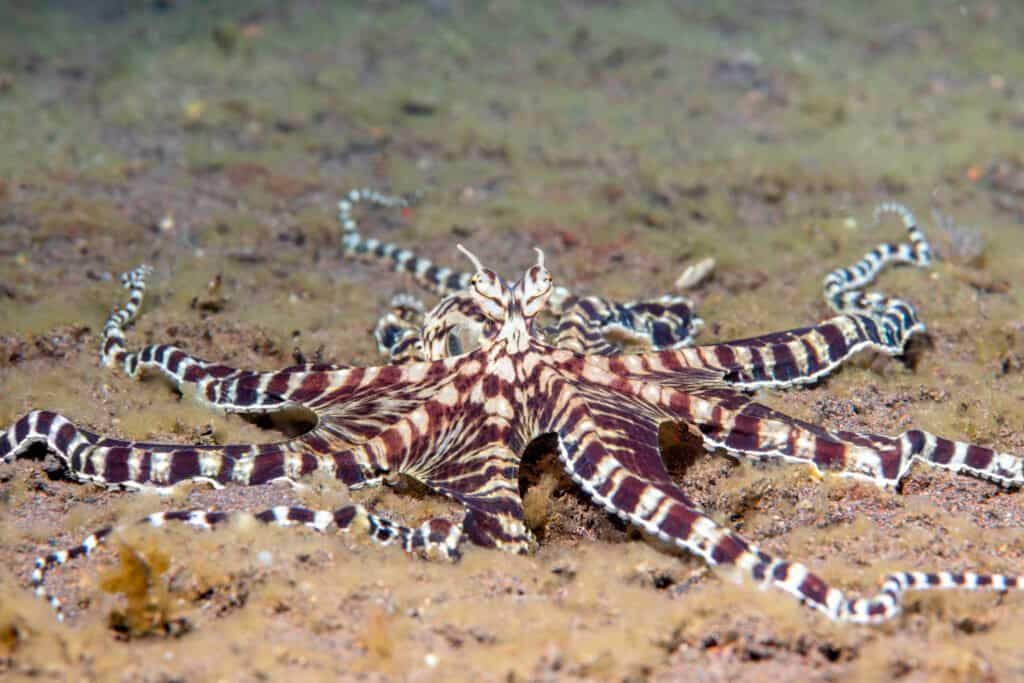
The mimic octopus can mimic various sea creatures.
©Joe Belanger/Shutterstock.com
Octopuses employ chromatophores to blend with their surroundings. However, one species of octopus can mimic many other marine animals. This octopus is called the mimic octopus. It is one of the most well-known animals capable of mimicry. It can resemble many aquatic creatures, including the venomous sole, sea snakes, lionfish, crabs, jellyfish, and mantis shrimp.
By impersonating other organisms, this octopus species fend off predators. The mimic octopus flattens its body to mimic the deadly sole fish. While imitating the jellyfish, it moves gently to the surface and spreads its arms equally around its body as it sinks.
Conclusion
Many animals and insects have evolved colors and shapes that allow them to blend in with their surroundings when feeding or resting. Whether the Atlas moth’s brightly colored, snake-like wings are the consequence of natural selection or a curious coincidence, they are truly a sight to behold. The fact that there are several examples of animal mimicry in nature highly suggests that its patterns evolved to aid it in its survival. What is most intriguing is that the Atlas Moth is one of the only creatures on Earth that has evolved to mimic a different animal species!
The photo featured at the top of this post is © iStock.com/SHAWSHANK61
FAQs (Frequently Asked Questions)
Fun Fact
Adult Atlas moths are unable to eat since they have no mouth! For energy, they depend on the fat reserves they built up as a caterpillar. Their lifespan is therefore short. More than a third of their lives are spent eating. In around 21 days, the pupa will transform into a beautiful butterfly. This little creature has a five to seven-day life span.
Thank you for reading! Have some feedback for us? Contact the AZ Animals editorial team.



